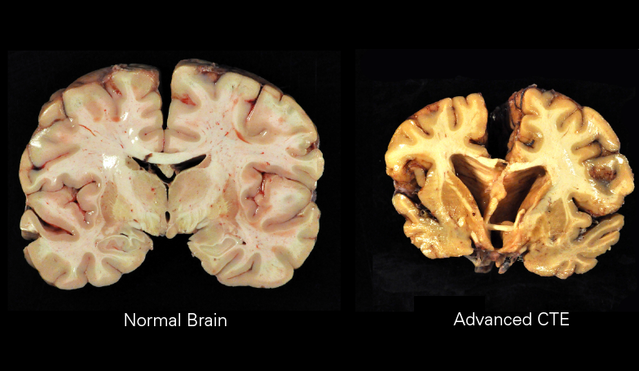Opinion | Let’s Talk About CTE


An image of chronic traumatic encephalopathy.
America loves their contact sports — and I get it. There’s nothing better than getting together with a group of friends and watching whatever game is on. There is a reason why sports are so popular and important in our culture, but that doesn’t mean that we can’t examine their impacts critically.
Chronic traumatic encephalopathy is a fatal brain disease that is associated with repeated head injuries. CTE is found in many professional athletes and military veterans, but also people who played sports nonprofessionally. It is found in many athletes who played football and hockey, as well as noncontact sports like soccer.
Despite common misconceptions, CTE doesn’t only come from contact sports, but can also result from repeated head injuries from varying sources. Many symptoms are similar to those that come with concussions, including memory loss, confusion, impaired judgment, impulse control problems and depression. Whether or not these symptoms are associated with CTE, they should be taken seriously as they are cues for other forms of head injuries.
The scariest thing about CTE is that it can only be diagnosed by analyzing brain tissue after death. Boston University’s CTE Center found that 345 out of the 376 deceased NFL players they have studied have been diagnosed with CTE. Athletes diagnosed include Rick Arrington from the Philadelphia Eagles and Ed Lothamer from Kansas City.
CTE got attention when Aaron Hernandez made headlines. Hernandez played for the New England Patriots where he was signed in 2012, earning $40 million dollars a year. In 2013, Hernandez murdered Odin Lloyd and was acquitted in the double murder of two other men. He committed suicide in his jail cell on April 19, 2017. Hernandez’s legal team never mentioned head injuries during the trial, but research suggests that CTE could have been a factor in his behavior. The evidence of the severity of his brain injuries was found in his autopsy that was presented in 2017.
The researchers studying his brain found the most severe case of CTE seen in someone under 46, which is astonishing considering that he was only 27 years old when he committed suicide.
CTE is something that needs exposure and should be talked about. It’s a hard thing to acknowledge without getting rid of all of the fun that comes with watching sports, but that doesn’t mean we can ignore it. CTE is often brought up in conversations surrounding the athletes who have gone on to commit horrific crimes, but there are other ways that brain injuries can ruin lives. Concussions can cause symptoms of mental illness and changes in mood. Post-concussion syndrome can also trigger migraines and dizziness. These criminal cases are few compared to the other lifelong impacts that come from CTE and post-concussion syndrome. Whether it is about CTE or not, head injuries are dangerous and should always be taken seriously.
Some professional athletes have spoken about their fears surrounding CTE. Chris Nilan was an enforcer in the NHL, getting into more than 300 fights during his time, and is at high risk for CTE. Nilan now participates in studies that will hopefully lead to answers one day and hosts a podcast titled “Raw Knuckles” where he talks about the more personal impacts of brain injuries.
There are also athletes like Carolina Panthers linebacker Thomas Davis, who have acknowledged their fears but feel that their love of the game outweighs the risks for them. This is also an understandable response, as there isn’t much to be done for their conditions — they can’t go back in time and not choose their careers.
Leagues are taking steps to limit brain injuries, including the laboratory testing of NFL helmets and restricting ways players can hit opponents, but it isn’t enough. Rules surrounding illegal hits don’t do enough to prevent concussions because players are still getting concussed all the time.
Concussion protocol in the NHL mostly revolves around identifying concussions once they already happened. It is good to pull players from the rink that have even a suspected concussion, but it won’t be enough in the long run. More attention should be on preventing these concussions from happening in the first place.
I think that people like avoiding the thought of CTE. It is much easier to ignore things that are scary and that we don’t know a lot about than to worry about them. Sports should remain enjoyable, but leagues should speak up about the truth of CTE. They should acknowledge the risk that their athletes are taking. Kids and parents should know what is at risk when they are signing up for contact sports.
Even if these kids aren’t at a serious risk for developing CTE from playing sports while young, they should still be careful to avoid head injuries. Research has found that kids playing tackle football get 15 times as many head injuries compared to kids playing flag football. The symptoms of post-concussion syndrome and CTE are not very different and can have a huge impact on quality of life.
Kids’ sports should be without contact for as long as possible. Sports can still be competitive without the contact which leads to dangerous injuries on all points of the body. Old-school sports fans will argue that toughness is important in building character in sports, but that simply isn’t true. Sports aren’t about mindlessly beating and injuring people. The strategy involved remains even when eliminating contact. You could argue that parents shouldn’t put their kids in contact sports if they won’t accept the risks of injuries, but parents aren’t always thinking of the worst-case scenario.
Our culture puts athletes on such a high pedestal where they reach this level of seeming unbreakable and invincible, but that is far from the truth. No matter how much they train, they are still humans and get hurt. No one is indestructible, and no matter how much athletes can profit off of their sport, whatever they gain isn’t a fair trade for their minds.
Jameson Keebler writes primarily about pop culture and current events. Write to her at jrk162@pitt.edu.
Recent Posts
‘He’s off to a much faster and better start’: Republicans reflect the second Trump administration’s first two months
Since Inauguration Day Trump’s second term has caused division amongst young Americans. Despite these controversies,…
Who Asked? // Why do we accept bad treatment from people?
This installment of Who Asked? by staff writer Brynn Murawski attempts to untangle the complicated…
What, Like It’s Hard? // Lean on your people
Contributing editor Livia LaMarca talks about leaning on your support networks and gives advice on…
Note to Self // Hot Girl Summer
In the sixth edition of Note to Self, Morgan Arlia talks about how she is…
A Good Hill to Die On // Down to Date and Time
In the latest version of “A Good Hill to Die On,” staff writer Sierra O’Neil…
‘Dress for Success: Closet to Career’ alleviates the stress of building a professional wardrobe
As the end of the spring semester rapidly approaches, many Pitt students find themselves in…


